TP-LINK Archer C5200 Manual

Archer C5200
User Guide
AC5200 Wireless Tri-band MU-MIMO Gigabit Router
1910011571 REV1.0.1
Contents
About This Guide................................................................................................ |
1 |
Chapter 1. Get to Know About You Router . . . . . . . . . . . . . . . . . . . . . . . . . . 2
1. 1. Product Overview . . . . . . . . . . . . . . . . . . . . . . . . . . . . . . . . . . . . . . . . . . . . . . . . . . . . . . . . . . 3
1. 2. Main Features . . . . . . . . . . . . . . . . . . . . . . . . . . . . . . . . . . . . . . . . . . . . . . . . . . . . . . . . . . . . . . 4
1. 3. Panel Layout. . . . . . . . . . . . . . . . . . . . . . . . . . . . . . . . . . . . . . . . . . . . . . . . . . . . . . . . . . . . . . . . 5
1. 3. 1.Top View . . . . . . . . . . . . . . . . . . . . . . . . . . . . . . . . . . . . . . . . . . . . . . . . . . . . . . . . . . . . . 5
1. 3. 2.The Back Panel . . . . . . . . . . . . . . . . . . . . . . . . . . . . . . . . . . . . . . . . . . . . . . . . . . . . . . . 6
Chapter 2. Connect the Hardware . . . . . . . . . . . . . . . . . . . . . . . . . . . . . . . . . . 8
2. 1. Position Your Router . . . . . . . . . . . . . . . . . . . . . . . . . . . . . . . . . . . . . . . . . . . . . . . . . . . . . . . . 9
2. 2. Connect Your Router . . . . . . . . . . . . . . . . . . . . . . . . . . . . . . . . . . . . . . . . . . . . . . . . . . . . . . . . 9
Chapter 3. Log into Your Router . . . . . . . . . . . . . . . . . . . . . . . . . . . . . . . . . . .12 Chapter 4. Set Up Internet Connection. . . . . . . . . . . . . . . . . . . . . . . . . . . . .14
4. 1. Quick Setup . . . . . . . . . . . . . . . . . . . . . . . . . . . . . . . . . . . . . . . . . . . . . . . . . . . . . . . . . . . . . . .15 4. 2. Manually Configure Your Internet Connection Settings. . . . . . . . . . . . . . . . . . . . . .15 4. 3. Setting Up an IPv6 Internet Connection . . . . . . . . . . . . . . . . . . . . . . . . . . . . . . . . . . . .19
Chapter 5. Guest Network. . . . . . . . . . . . . . . . . . . . . . . . . . . . . . . . . . . . . . . . .23
5. 1. |
Create Guest Network . . . . . . . . . . . . . . . . . . . . . . . . . . . . . . . . . . . . . . . . . . . . . . . . . . . . . |
24 |
5. 2. |
Customize Guest Network Options . . . . . . . . . . . . . . . . . . . . . . . . . . . . . . . . . . . . . . . . . |
25 |
Chapter 6. USB Application . . . . . . . . . . . . . . . . . . . . . . . . . . . . . . . . . . . . . . .26
6. 1. Local Storage Sharing . . . . . . . . . . . . . . . . . . . . . . . . . . . . . . . . . . . . . . . . . . . . . . . . . . . . . .27 6. 1. 1.Access the USB Disk . . . . . . . . . . . . . . . . . . . . . . . . . . . . . . . . . . . . . . . . . . . . . . . . . 27 6. 1. 2.Customize Your Settings . . . . . . . . . . . . . . . . . . . . . . . . . . . . . . . . . . . . . . . . . . . . .29
6. 2. Remote Access via FTP Server . . . . . . . . . . . . . . . . . . . . . . . . . . . . . . . . . . . . . . . . . . . . . .32 6. 2. 1.Access the USB Disk . . . . . . . . . . . . . . . . . . . . . . . . . . . . . . . . . . . . . . . . . . . . . . . . . 32 6. 2. 2.Customize Your Settings . . . . . . . . . . . . . . . . . . . . . . . . . . . . . . . . . . . . . . . . . . . . .35
6. 3. Media Sharing . . . . . . . . . . . . . . . . . . . . . . . . . . . . . . . . . . . . . . . . . . . . . . . . . . . . . . . . . . . . .36 6. 3. 1.Access the USB Disk . . . . . . . . . . . . . . . . . . . . . . . . . . . . . . . . . . . . . . . . . . . . . . . . . 37
6. 3. 2.Customize Your Settings . . . . . . . . . . . . . . . . . . . . . . . . . . . . . . . . . . . . . . . . . . . . .38 6. 4. Printer Sharing. . . . . . . . . . . . . . . . . . . . . . . . . . . . . . . . . . . . . . . . . . . . . . . . . . . . . . . . . . . . .39 6. 5. 3G/4G Networking Sharing. . . . . . . . . . . . . . . . . . . . . . . . . . . . . . . . . . . . . . . . . . . . . . . . .42
Chapter 7. Parental Controls . . . . . . . . . . . . . . . . . . . . . . . . . . . . . . . . . . . . . .45
Chapter 8. QoS (Quality of Service) . . . . . . . . . . . . . . . . . . . . . . . . . . . . . . . .49
8. 1. Prioritize Internet Traffic with QoS . . . . . . . . . . . . . . . . . . . . . . . . . . . . . . . . . . . . . . . . . .50 8. 2. Update the Database . . . . . . . . . . . . . . . . . . . . . . . . . . . . . . . . . . . . . . . . . . . . . . . . . . . . . .52
Chapter 9. Network Security . . . . . . . . . . . . . . . . . . . . . . . . . . . . . . . . . . . . . .54
9. 1. Protect the Network from Cyber Attacks . . . . . . . . . . . . . . . . . . . . . . . . . . . . . . . . . . . .55 9. 2. Access Control . . . . . . . . . . . . . . . . . . . . . . . . . . . . . . . . . . . . . . . . . . . . . . . . . . . . . . . . . . . . .56 9. 3. IP & MAC Binding . . . . . . . . . . . . . . . . . . . . . . . . . . . . . . . . . . . . . . . . . . . . . . . . . . . . . . . . . .58
Chapter 10.NAT Forwarding . . . . . . . . . . . . . . . . . . . . . . . . . . . . . . . . . . . . . . .59
10. 1. Share Local Resources in the Internet by Virtual Server . . . . . . . . . . . . . . . . . . . . . .60 10. 2. Open Ports Dynamically by Port Triggering . . . . . . . . . . . . . . . . . . . . . . . . . . . . . . . . .61 10. 3. Make Applications Free from Port Restriction by DMZ . . . . . . . . . . . . . . . . . . . . . . .62 10. 4. Make Xbox Online Games Run Smoothly by UPnP . . . . . . . . . . . . . . . . . . . . . . . . . . 63
Chapter 11.VPN Server . . . . . . . . . . . . . . . . . . . . . . . . . . . . . . . . . . . . . . . . . . . .65
11. 1. Use OpenVPN to Access Your Home Network . . . . . . . . . . . . . . . . . . . . . . . . . . . . . . .66 11. 2. Use PPTP VPN to Access Your Home Network . . . . . . . . . . . . . . . . . . . . . . . . . . . . . . .67
Chapter 12.Customize Your Network Settings. . . . . . . . . . . . . . . . . . . . . . .72
12. 1. Change the LAN Settings. . . . . . . . . . . . . . . . . . . . . . . . . . . . . . . . . . . . . . . . . . . . . . . . . . .73 12. 2. Configure to Support IPTV Service. . . . . . . . . . . . . . . . . . . . . . . . . . . . . . . . . . . . . . . . . .73 12. 3. Specify DHCP Server Settings . . . . . . . . . . . . . . . . . . . . . . . . . . . . . . . . . . . . . . . . . . . . . .75 12. 4. Set Up a Dynamic DNS Service Account . . . . . . . . . . . . . . . . . . . . . . . . . . . . . . . . . . . .76 12. 5. Create Static Routes. . . . . . . . . . . . . . . . . . . . . . . . . . . . . . . . . . . . . . . . . . . . . . . . . . . . . . . .77 12. 6. Specify Wireless Settings . . . . . . . . . . . . . . . . . . . . . . . . . . . . . . . . . . . . . . . . . . . . . . . . . . .79 12. 7. Use WPS for Wireless Connection . . . . . . . . . . . . . . . . . . . . . . . . . . . . . . . . . . . . . . . . . . .81
12. 7. 1.Set the Router’s PIN. . . . . . . . . . . . . . . . . . . . . . . . . . . . . . . . . . . . . . . . . . . . . . . . .81 12. 7. 2.Use the WPS Wizard for Wi-Fi Connections. . . . . . . . . . . . . . . . . . . . . . . . . . .81 12. 8. Schedule Your Wireless Function . . . . . . . . . . . . . . . . . . . . . . . . . . . . . . . . . . . . . . . . . . .82
Chapter 13.Manage the Router . . . . . . . . . . . . . . . . . . . . . . . . . . . . . . . . . . . .84
13. 1. Set Up System Time . . . . . . . . . . . . . . . . . . . . . . . . . . . . . . . . . . . . . . . . . . . . . . . . . . . . . . . .85 13. 2. Test the Network Connectivity . . . . . . . . . . . . . . . . . . . . . . . . . . . . . . . . . . . . . . . . . . . . .86 13. 3. Upgrade the Firmware . . . . . . . . . . . . . . . . . . . . . . . . . . . . . . . . . . . . . . . . . . . . . . . . . . . . .88 13. 4. Backup and Restore Configuration Settings . . . . . . . . . . . . . . . . . . . . . . . . . . . . . . . . .88 13. 5. Change the Administrator Account . . . . . . . . . . . . . . . . . . . . . . . . . . . . . . . . . . . . . . . . .89 13. 6. Password Recovery . . . . . . . . . . . . . . . . . . . . . . . . . . . . . . . . . . . . . . . . . . . . . . . . . . . . . . . .90 13. 7. Local Management . . . . . . . . . . . . . . . . . . . . . . . . . . . . . . . . . . . . . . . . . . . . . . . . . . . . . . . .91 13. 8. Remote Management. . . . . . . . . . . . . . . . . . . . . . . . . . . . . . . . . . . . . . . . . . . . . . . . . . . . . .92 13. 9. System Log . . . . . . . . . . . . . . . . . . . . . . . . . . . . . . . . . . . . . . . . . . . . . . . . . . . . . . . . . . . . . . . .93 13. 10. Monitor the Internet Traffic Statistics . . . . . . . . . . . . . . . . . . . . . . . . . . . . . . . . . . . . . . .95 13. 11. Control LEDs. . . . . . . . . . . . . . . . . . . . . . . . . . . . . . . . . . . . . . . . . . . . . . . . . . . . . . . . . . . . . . .96
FAQ...................................................................................................................... |
98 |
Specifications................................................................................................. |
109 |

About This Guide
This guide provides details of each function and shows how to configure the router appropriate to your needs. In addition to this guide, a Quick Installation Guide is also released with each TP-LINK router, you are suggested to configure your router for quick Internet setup by following the published Quick Installation Guide before you get started with a further configuration.
Conventions
In this guide the following conventions are used:
Convention |
Description |
|
router |
Stands for AC5200WirelessTri-Band MU-MIMO Gigabit Router without any explanation. |
|
|
|
|
|
Parameters provided in the screenshots are just references for setting up the device, |
|
parameters |
which may differ from the actual situation. You can set the parameters according to |
|
|
your demand. |
|
|
|
|
|
The demonstrated screenshots may look a little different from the actual web page of |
|
screenshots |
your device due to the various firmware versions. Please just configure your product |
|
|
based on the actual web page. |
|
|
|
|
Blue Italic |
Hyperlinks are in blue italic. You can click to redirect to a website or a specific section. |
|
|
|
|
Blue |
Contents to be emphasized and texts on the web page are in blue, including the |
|
menus, items, buttons, etc. |
||
|
The menu structures to show the path to load the corresponding page. For example,
>Advanced > Wireless > MAC Filtering means the MAC Filtering function page is under the Wireless menu that is located in the Advanced tab.
|
|
Note: |
Ignoring this type of note might result in a malfunction or damage to the device. |
|||
|
|
|||||
|
|
|
|
|
|
|
|
|
|
Tips: |
Indicates important information that helps you make better use of your device. |
||
|
|
|
||||
|
|
|
||||
|
|
|
|
|
|
|
symbols on the web |
• |
click to edit the corresponding entry. |
||||
• |
click to delete the corresponding entry. |
|||||
page |
||||||
|
|
|
|
• |
click to enable or disable the corresponding entry. |
|
1

Chapter 1
Get to Know About You Router
This chapter introduces what the router can do and shows its main features and appearance.
This chapter contains the following sections:
•Product Overview
•Main Features
•Panel Layout
Chapter 1 |
|
1. 1. Product Overview
What This Product Does
TP-LINK’s Archer C5200 integrates 4-port Switch, Firewall, NAT-router and Wireless AP. Powered by Multi-User MIMO technology, the Archer C5200 delivers exceptional range and speed, which can fully meet the need of Small Office/Home Office (SOHO) networks and the users demanding higher networking performance. Your wireless connections are radio band selectable to avoid interference in your area, and the four built-in Gigabit ports supply high-speed connection to your wired devices.
802.11ac - The Next Generation of Wi-Fi
TP-LINK’s Archer C5200 comes with the next generation Wi-Fi standard – 802.11ac, backward compatible with 802.11n and 3 times faster than wireless N speeds. With higher power efficiency and robust security, 802.11ac is the perfect way to accelerate a home multimedia network and solve congestion that multiple devices may cause.
3166Mbps Concurrent Trinal Band - More Bandwidth, Less Interference
With 2166Mbps wireless speeds over the crystal clear 5GHz band and 1000Mbps over the 2.4GHz band, Archer C5200 offers you the flexibility of three dedicated networks and ensures amazing wireless performance. Simple tasks such as sending e-mails or web browsing can be handled by the 2.4GHz band while bandwidth intensive tasks like online gaming or HD video streaming can be processed by the 5GHz band - all at the same time.
Multifunctional USB Port - Easy Storage and Sharing
Using the Archer C5200’s multi-functional USB 3.0 port, you can share a printer with multiple computers and devices on your network and can also share files & media at home or via the FTP server while away from home.
Guest Network
Guest Network Access provides secure Wi-Fi access for guests sharing your home or office network in a controlled manner without exposing private Wi-Fi access codes or other personal data.
IPv6 Supported
Archer C5200 supports IPv6, which is the foundation of the next generation of the Internet and enables a range of new services and improved user experience.
Parental Control
Parental Controls allow parents or administrators to deploy restricted access for children or staff. With URL blocking, you can easily set up a black or white list to limit the level of web access.
3
Chapter 1 |
|
Tether APP
TP-LINK Tether provides the easiest way to access and manage your router with your wireless devices.
1. 2. Main Features
•Supports 802.11ac Muti-User MIMO
•Supports 802.11ac - The next generation of Wi-Fi, compatible with 802.11n
•Simultaneous 2.4GHz 1000Mbps and 5GHz 2166Mbps connections for 3166Mbps of total available bandwidth
•8 dual band fixed external antennas and high power amplifiers provide stable signals and optimal wireless coverage
•Provides WPA/WPA2, WPA-PSK/WPA2-PSK authentication, TKIP/AES encryption security
•Supporting Dynamic IP/Static IP/PPPoE/PPTP/L2TP Internet access
•Supports USB Storage Sharing, Print Server, FTP Server, Media Server. Shares a printer locally and files & media with networked devices or remotely via FTP server
•Built-in NAT and DHCP server supporting static IP address distributing
•Guest Network access provides secure Wi-Fi access for guests sharing your home or office network
•Parental Controls allow parents or administrators to establish restricted access policies for children or staff
•Quality of Service (QoS) makes it easier for you to manage the bandwidth of devices connected to the router
•Supports IP/MAC filter and URL filter, Access Control list
•SPI and NAT firewall protects end-user devices from potential attacks from the Internet
•Easy one-touch WPA wireless security encryption with the WPS button
•Wi-Fi On/Off Button allows users to turn their wireless radio on or off
•Supports firmware upgrade and Web management
•Supports Virtual Server, DMZ host and Port Triggering
•Supports Dynamic DNS, UPnP and Static Routing
•Provides Automatic-connection and Scheduled Connection on certain time to the Internet
•Supports system log and Traffic Statistics
•Supports IPv6
4
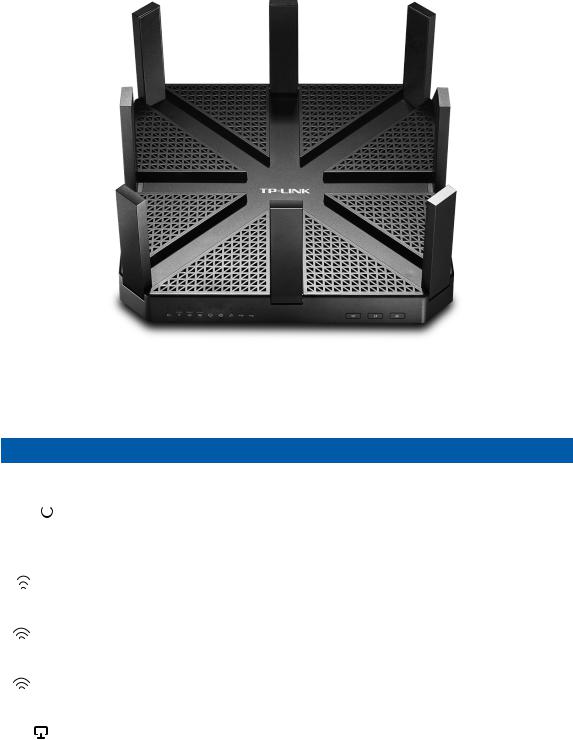
Chapter 1 |
|
1. 3. Panel Layout
1. 3. 1. Top View
The router’s LEDs (view from left to right) are located on the front. You can check the router’s working status by following the LED Explanation table.
LED Explanation
|
|
Name |
Status |
Indication |
|
|
|
|
|
|
|
|
|
|
On |
System initialization completes. |
|
|
|
|
|
|
|
|
|
(Power) |
Flashing |
System initialization or firmware upgrade is in process. Do not |
|
|
|
disconnect or power off the router. |
|||
|
|
|
|
||
|
|
|
|
|
|
|
|
|
Off |
Power is off. |
|
|
|
|
|
|
|
|
|
|
On |
The 2.4GHz wireless band is working properly. |
|
(2.4GHz Wireless) |
|
|
|||
Off |
The 2.4 GHz wireless band is disabled. |
||||
|
|
|
|||
|
|
|
|
|
|
|
|
|
On |
The 5GHz-1 wireless band is working properly. |
|
( 5GHz-1 Wireless) |
|
|
|||
Off |
The 5GHz-1 wireless band is disabled. |
||||
|
|
|
|||
|
|
|
|
|
|
|
|
|
On |
The 5GHz-2 wireless band is working properly. |
|
( 5GHz-2 Wireless) |
|
|
|||
Off |
The 5GHz-1 wireless band is disabled. |
||||
|
|
|
|||
|
|
|
|
|
|
|
|
|
On |
At least one Ethernet port is connected. |
|
|
|
(Ethernet) |
|
|
|
Off |
No Ethernet port is connected. |
||||
|
|
|
|||
|
|
|
|
|
|
5

Chapter 1
LED Explanation
Name |
Status |
Indication |
|
|
Blue On |
Internet is available. |
|
|
|
|
|
(Internet) |
Orange On |
The router’s Internet port is connected, but the Internet |
|
is not available. |
|||
|
|
||
|
|
|
|
|
Off |
The router’s Internet port is not connected. |
|
|
|
|
|
|
On/Off |
Turns On when a WPS synchronization is established and |
|
|
automatically turns Off about 5 minutes later. |
||
|
|
||
(WPS) |
|
|
|
Flashing |
A wireless device is trying to connect to the network via WPS. This |
||
|
|||
|
process may take up to 2 minutes. |
||
|
|
||
|
|
|
|
|
On |
The USB device is identified and ready to use. |
|
|
|
|
|
(USB) |
Flashing |
The USB device is being identified. |
|
|
|
||
Off |
No USB device is plugged into the USB port or the USB device is not |
||
|
|||
|
identified or USB device has been safely ejected. |
||
|
|
||
|
|
|
The following buttons (view from left to right) are also located on the front panel.
Button Description
Buttons |
Description |
|
|
|
|
(Wi-Fi Button) |
Press this Wi-Fi button for about 2 seconds to turn on or off the wireless function of |
|
your router. |
||
|
||
|
|
|
|
Press this WPS button, and immediately press the WPS button on your client device. |
|
(WPS Button) |
The WPS LED of the router should change from flashing to solid on, indicating |
|
|
successful WPS connection. |
|
|
|
|
(LED Button) |
Press the LED button for about 1 second to turn on or off the LEDs of your router. |
|
|
|
1. 3. 2. The Back Panel
6

Chapter 1 |
|
The following parts (view from left to right) are located on the rear panel.
Item |
Description |
|
|
|
|
Reset Button |
Press this button for about 7 seconds to reset the router. |
|
|
|
|
USB 2.0 Port |
Connect your USB 2.0 storage device or USB 2.0 printer to this port. |
|
|
|
|
Internet Port |
This port is where you’ll connect to the DSL/Cable modem, or Ethernet. |
|
|
|
|
Ethernet Ports (1/2/3/4) |
Connect your Etherent devices, like PCs, to these ports. |
|
|
|
|
USB 3.0 Port |
Connect your USB 3.0 storage device or USB 3.0 printer to this port. |
|
|
|
|
Power On/Off Button |
Press this button to power on or off the router. |
|
|
|
|
Power Port |
This port is where you will connect the power socket via the provided power |
|
adapter. |
||
|
||
|
|
7

Chapter 2
Connect the Hardware
This chapter contains the following sections:
•Position Your Router
•Connect Your Router

Chapter 2 |
|
2. 1. Position Your Router
•The Product should not be located where it will be exposed to moisture or excessive heat.
•Place the router in a location where it can be connected to the various devices as well as to a power source.
•Make sure the cables and power cord are safely placed out of the way so they do not create a tripping hazard.
•The router can be placed on a shelf or desktop.
•Keep away from the strong electromagnetic radiation and the device of electromagnetic sensitive.
2. 2. Connect Your Router
1. Follow the steps below to connect your router.
If your Internet connection is through an Ethernet cable from the wall instead of through a DSL / Cable / Satellite modem, connect the Ethernet cable directly to the router’s Internet port, then follow steps 5 and 6 to complete the hardware connection.
 1
1
5
Internet
2
Power adapter
1 ) Place the router horizontally and extend the antennas to the maximum angle.
 Note:
Note:
For best performance, horizontal installation is recommended. Antenna direction and position can affect performance in vertical installation situations.
2 ) Turn off the modem, and remove the backup battery if it has one.
9
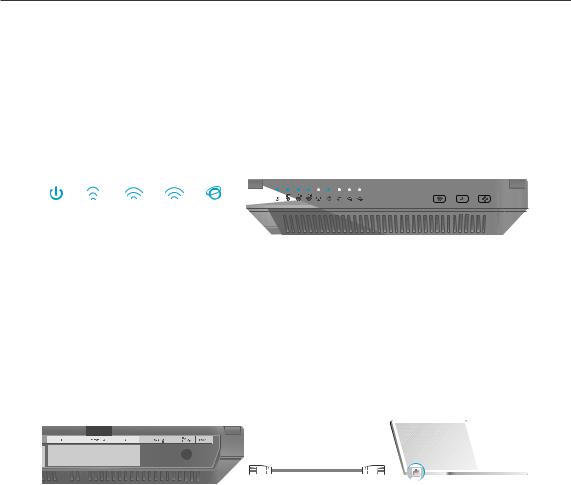
Chapter 2
3 ) |
Connect the modem to the Internet port on your router with an Ethernet cable. |
||||
4 ) |
Turn on the modem, and then wait about 2 minutes for it to restart. |
||||
5 ) |
Turn on the router. |
|
|||
6 ) |
Verify that the following LEDs are on and stable before continuing with the |
||||
|
configuration. |
|
|
||
|
Power |
2.4GHz |
5GHz-1 |
5GHz-2 |
Internet |
|
On |
On |
On |
On |
On |
 Tips:
Tips:
1.If all the LEDs are off, press the LED On/Off button  for about 1 second, then check the LEDs again.
for about 1 second, then check the LEDs again.
2.If the 2.4GHz, 5GHz-1, and 5GHz-2 LEDs are off, press the Wi-Fi On/Off button  for about 2 seconds, then check the LEDs again in a few seconds.
for about 2 seconds, then check the LEDs again in a few seconds.
2.Connect your computer to the router.
• Method 1: Wired
Turn off the Wi-Fi on your computer and connect the devices as shown below.
Ethernet Cable
• Method 2: Wirelessly
Connect wirelessly by using the SSID (Network Name) and Wireless Password/PIN printed on the product label at the bottom of the router.
• Method 3: Use the WPS button
Wireless devices that support WPS, including Android phones, tablets, most USB network cards, can be connected to your router through this method. (WPS is not supported by IOS devices.)
 Note:
Note:
The WPS function cannot be configured if the wireless function of the router is disabled. Also, the WPS function will be disabled if your wireless encryption is WEP. Please make sure the wireless function is enabled and is configured with the appropriate encryption before configuring the WPS.
1.Tab the WPS icon on the device’s screen.
2.Immediately press the WPS button on your router.
10

Chapter 2 |
|
Close to
11

Chapter 3
Log into Your Router
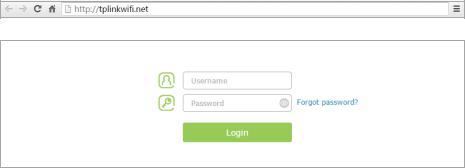
Chapter 3 |
|
With a Web-based utility, it is easy to configure and manage the rouer. The Web-based utility can be used on any Windows, Macintosh or UNIX OS with a Web browser, such as Microsoft Internet Explorer, Mozilla Firefox or Apple Safari.
Follow the steps below to log into your router.
1.Set up the TCP/IP Protocol in Obtain an IP address automatically mode on your computer.
2.Visit http://tplinkwifi.net, and log in with the username and password you‘ve set for the router. The default one is admin for both username and password.
 Note:
Note:
If the login window does not appear, please refer to FAQ.
13

Chapter 4
Set Up Internet Connection
This chapter introduces how to connect your router to the Internet. The router is equipped with a web-based Quick Setup wizard. It has many ISP information built in, automates many of the steps and verifies that those steps have been successfully completed. Furthermore, you can also set up an IPv6 connection if your ISP provided IPv6 service.
This chapter contains the following sections:
•Quick Setup
•Manually Configure Your Internet Connection Settings
•Setting Up an IPv6 Internet Connection

Chapter 4 |
|
4. 1. Quick Setup
The Quick Setup Wizard will guide you through the process to set up your router to access the Internet.
 Tips:
Tips:
If you need the IPv6 Internet connection, please refer to the section of Setting Up an IPv6 Internet Connection.
1.Visit http://tplinkwifi.net, and log in with the username and password you set for the router.
2.Click Quick Setup on the top of the page, and follow the step-by-step instructions to set up your router to access the Internet.
4.2. Manually Configure Your Internet Connection Settings
In this part, you can check your current Internet connection settings. You can also modify the settings according to the service information provided by your ISP.
Follow the steps below to check or modify your Internet connection settings.
1.Visit http://tplinkwifi.net, and log in with the username and password you set for the router.
2.Go to Basic > Internet.
3.Select your Internet connection type from the drop-down list.
 Note:
Note:
If you are unsure what your connection type is, click Auto Detect. Since different connection types need different cables and connection information, you can also refer to the demonstrations in Step 4 to judge your connection type.
4.Follow the instructions on the page to continue the configuration. Parameters on the figures are just used for demonstration.
1 ) If you choose Dynamic IP, you need to select whether to clone the MAC address or not. Dynamic IP users are usually equipped with cable TV or fiber cable.
15
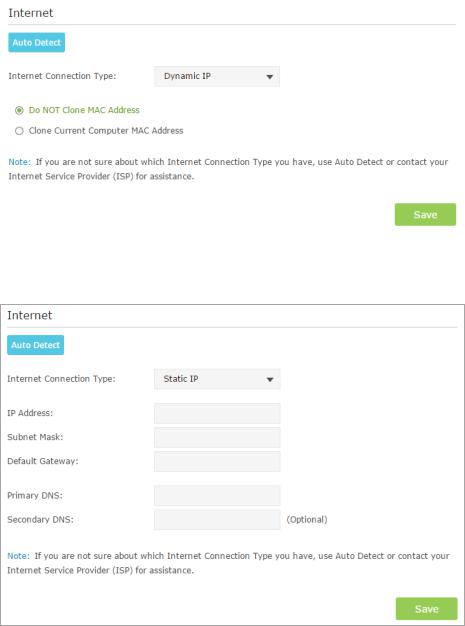
Chapter 4 |
|
|
|
|
|
|
|
|
2 ) If you choose Static IP, enter the information provided by your ISP in the corresponding fields.
3 ) If you choose PPPoE, enter the Username and Password provided by your ISP. PPPoE users usually have DSL cable.
16
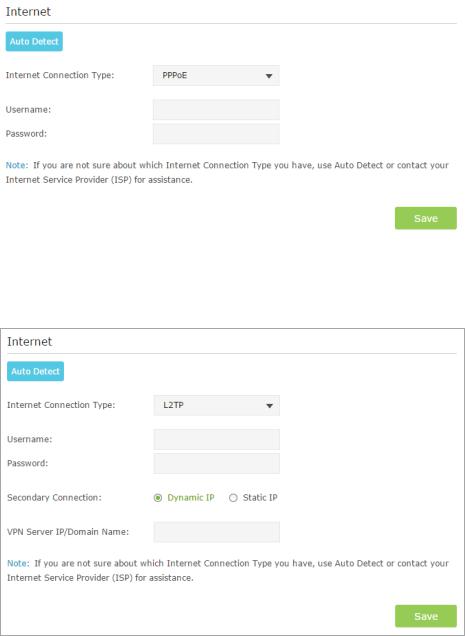
Chapter 4 |
|
|
|
|
|
|
|
|
4 ) If you choose L2TP, enter the Username and Password and choose the Secondary Connection provided by your ISP. Different parameters are needed according to the Secondary Connection.
5 ) If you choose PPTP, enter the Username, Password and choose the Secondary Connection provided by your ISP. Different parameters are needed according to the Secondary Connection.
17
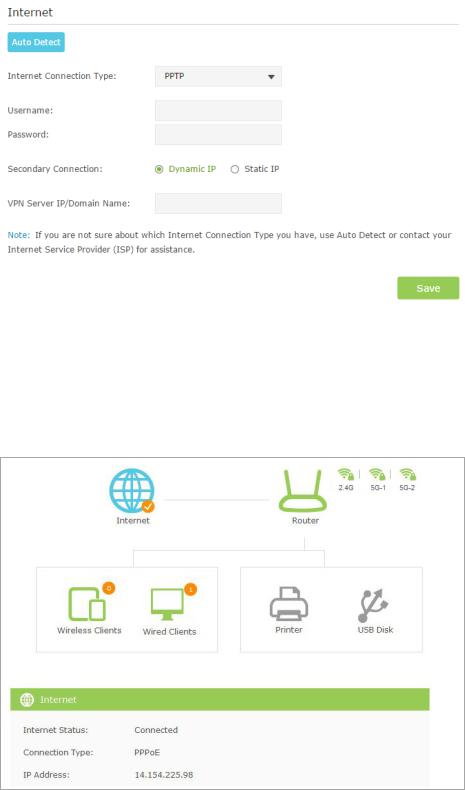
Chapter 4 |
|
|
|
|
|
|
|
|
5. Click Save to make the settings take effect. To check your Internet connection, click Network Map on the left of the page.
 Note:
Note:
It may take 1-2 minutes to make the settings valid.
6.After the connection succeed, the screen will display as follows. Here we take PPPoE as an example.
 Tips:
Tips:
1.If your Internet connection type is BigPond Cable, please go to Advanced > Network > Internet.
2.If you use Dynamic IP and PPPoE and you are provided any other parameters that are not required on the page, please go to Advanced > Network > Internet to complete the configuration.
3.If you still cannot connect to the Internet, refer to FAQ for further instructions.
18
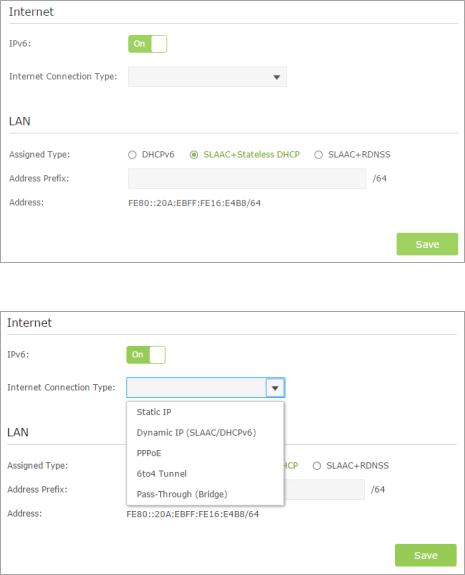
Chapter 4 |
|
4. 3. Setting Up an IPv6 Internet Connection
Your ISP provides information about one of the following Internet connection types: PPPoE, Dynamic IP(SLAAC/DHCPv6), Static IP, 6to4 tunnel, Pass-Through (Bridge).
1.Visit http://tplinkwifi.net, then log in with the username and password you set for the router.
2.Go to Advanced > IPv6.
3. Select the Internet connection type provided by ISP.
 Tips:
Tips:
If you do not know what your Internet connection type is, contact your ISP or judge according to already known information provided by your ISP.
4.Fill in information as required by different connection type. (Red blanks must be filled.)
1 ) Static IP: Fill in blanks and click Save.
19

Chapter 4 |
|
|
|
|
|
|
|
|
2 ) Dynamic IP(SLAAC/DHCPv6): Click Advanced to have more configuration if ISP requires. Click Save to save the settings and then click Renew to finish the configuration.
3 ) PPPoE: Fill in the Username and Password. Click Advanced to have more configuration if ISP requires. Click Save to save the settings and then click Connect to finish the configuration.
20

Chapter 4 |
|
|
|
|
|
|
|
|
4 ) 6to4 Tunnel: An IPv4 Internet connection type is a prerequisite for this connection type. (4. 2) Click Advanced to have more configuration if ISP requires. Click Save to save the settings and then click Connect to finish the configuration.
5 ) Pass-Through (Bridge): Click Save and skip to step 6.
21
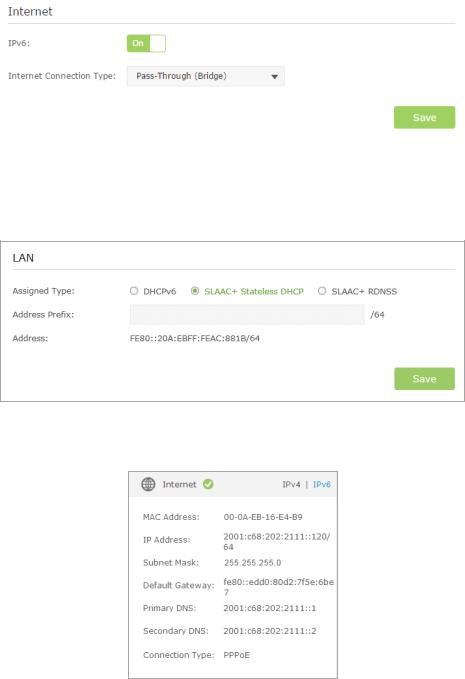
Chapter 4 |
|
|
|
|
|
|
|
|
5. Configure LAN ports. Windows users are recommended to choose from the first two types. Fill in Address Prefix provided by ISP, and click Save to save the settings.
 Tips:
Tips:
Find Help on the management interface to know more about items.
6.Click Status to check whether you succeed or not. The following figure is an example of a successful PPPoE configuration.
 Tips:
Tips:
Visit FAQ if there is no Internet connection.
22

Chapter 5
Guest Network
This function allows you to provide Wi-Fi access for guests without disclosing your main network. When you have guests in your house, apartment, or workplace, you can create a guest network for them. In addition, you can limit the network authorities for guests to ensure network security and privacy.
This chapter contains the following sections:
•Create Guest Network
•Customize Guest Network Options
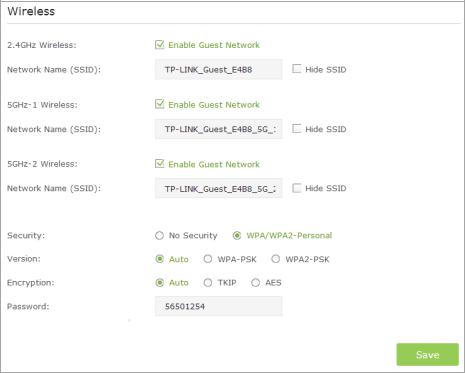
Chapter 5 |
|
5. 1. Create Guest Network
1.Visit http://tplinkwifi.net, and log in with the username and password you set for the router.
2.Go to Advanced > Guest Network.
3.Create a 2.4GHz, 5GHz-1 and/or 5GHz-2 guest network according to your needs.
1 ) Enable Guest Network of 2.4GHz Wireless, 5GHz-1 Wireless and/or 5GHz-2 Wireless.
2 ) Set an easy-to-identify SSID. Don‘t select Hide SSID unless you want your guests and other people to manually input this SSID for Wi-Fi access.
3 ) Set Security to WPA/WPA2 Personal, keep the default Version and Encryption values, and set an easy-to-remember Password.
4. Click Save. Now your guests can access your guest network using the SSID and password you‘ve set!
 Tips:
Tips:
To view guest network information, go to Advanced > Status and find the Guest Network section.
24

Chapter 5 |
|
5. 2. Customize Guest Network Options
1.Visit http://tplinkwifi.net, and log in with the username and password you set for the router.
2.Go to Advanced > Guest Network.
3.Customize guest network options according to your needs.
•Allow guests to see each other
Tick this checkbox to allow the clients in your guest network to access each other.
•Allow guests to access my local network
Tick this checkbox to allow the clients in your guest network to access your local network, not just Internet access.
4. Click Save. Now users in your guest network can enjoy only the network authorities you’ve assigned!
 Tips:
Tips:
To view guest network information, go to Advanced > Status and find the Guest Network section.
25

Chapter 6
USB Application
This chapter describes how to share and access USB devices connected to the router among different clients.
The router only supports USB external flash drives, hard drives, USB printers and USB 3G/4G modems.
This chapter contains the following sections:
•Local Storage Sharing
•Remote Access via FTP Server
•Media Sharing
•Printer Sharing
•3G/4G Networking Sharing
